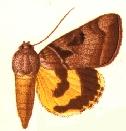
North Dakota is a state in the Midwestern United States. It is named after the Lakota and Dakota Sioux Native American tribes, who comprise a large portion of the population and historically dominated the territory. It is the nineteenth largest in area, the fourth least populous, and the fourth most sparsely populated of the 50 states. Its capital is Bismarck, and its largest city is Fargo.

The Pyralidae, commonly called pyralid moths, snout moths or grass moths, are a family of Lepidoptera in the ditrysian superfamily Pyraloidea. In many classifications, the grass moths (Crambidae) are included in the Pyralidae as a subfamily, making the combined group one of the largest families in the Lepidoptera. The latest review by Eugene G. Munroe and Maria Alma Solis, in Kristensen (1999) retains the Crambidae as a full family of Pyraloidea.

Prunus virginiana, commonly called bitter-berry, chokecherry, Virginia bird cherry, and western chokecherry, is a species of bird cherry native to North America. The natural historic range of P. virginiana includes most of Canada, most of the United States, and northern Mexico.
The North Dakota Fighting Hawks represent the University of North Dakota, competing as a member of the Missouri Valley Football Conference (MVFC) in the NCAA Division I's Football Championship Subdivision. From 1973 to 2008, they played in the NCAA's NCAA Division II, winning the National Championship in 2001. From 1955 to 1972, they competed in the NCAA's College Division where they participated in and won three bowl games.

The North Dakota State Bison football program represents North Dakota State University in college football at the NCAA Division I Football Championship Subdivision level and competes in the Missouri Valley Football Conference. The Bison play in the 19,000 seat Fargodome located in Fargo. The Bison have won sixteen national championships and 36 conference championships. They won five-consecutive NCAA Division I FCS National Championships between 2011 and 2015 as well as three more consecutively between 2017 and 2019. NDSU is the only college football program to ever win five consecutive NCAA national championships, and hold the record for most FCS titles with eight.

Catocala whitneyi, or Whitney's underwing, is a moth of the family Erebidae. The species was first described by G. M. Dodge in 1874. It is found in North America from North Dakota, Nebraska, and Kansas eastward through Wisconsin to Ohio and Tennessee. It has also been recorded as far west as Minnesota and Utah. In Canada, it has been found in Manitoba.

Virbia aurantiaca, the orange holomelina, is a moth species of the family Erebidae found in North America. In the east it has been recorded from Manitoba and Nova Scotia, south along the eastern seaboard to Cordoba in Mexico. It has also been recorded from Texas, Mississippi, Missouri, Tennessee, Louisiana, Oklahoma, Kansas, North Dakota and South Dakota.

Protolampra brunneicollis, the brown-collared dart, is a moth of the family Noctuidae. The species was first described by Augustus Radcliffe Grote in 1864. It is found in eastern North America from New Brunswick to Alberta in southern Canada, and in the United States from Maine to North Carolina and Tennessee west to Mississippi, north to Minnesota, with scattered records in the west from North Dakota, South Dakota and Montana.

Speranza pustularia, the lesser maple spanworm, is a moth of the family Geometridae. It is found from Nova Scotia to Florida, west to Mississippi, north to North Dakota and Saskatchewan.

Diploschizia impigritella, the yellow nutsedge moth or the five-barred glyphipterid moth, is a species of sedge moth in the genus Diploschizia. It was described by James Brackenridge Clemens in 1862. It is found in North America, from Newfoundland to Florida, west to Texas and North Dakota. It has also been recorded from California.

The 2013 North Dakota State Bison football team represented North Dakota State University in the 2013 NCAA Division I FCS football season. They were led by head coach Craig Bohl, in his 11th and ultimately final season, as he left to become the head coach at Wyoming after the season. The team, which played their 21st season in the Fargodome, entered the season as the two-time defending national champions. The Bison have been members of the Missouri Valley Football Conference since the 2008 season.
Cochylichroa arthuri, Arthur’s sunflower moth, is a species of moth of the family Tortricidae. It is found in North America, where it has been recorded from Saskatchewan, Manitoba, North Dakota, Indiana, Minnesota, Montana and Ohio.
Petrophila avernalis is a moth in the family Crambidae. It was described by Augustus Radcliffe Grote in 1878. It is found in North America, where it has been recorded from Arizona, Colorado, New Mexico, South Dakota and Wyoming.

Crambus laqueatellus, the eastern grass-veneer, is a moth in the family Crambidae. It was described by James Brackenridge Clemens in 1860. It is found in North America, where it has been recorded from Ontario and Maine to South Carolina, west to Texas and north to North Dakota.
Crambus trichusalis is a moth in the family Crambidae. It was described by George Duryea Hulst in 1886. It is found in North America, where it has been recorded from Alberta, Saskatchewan, Montana, North Dakota and South Dakota. The habitat consists of grasslands.
Donacaula sordidellus is a moth in the family Crambidae. It was described by Johann Leopold Theodor Friedrich Zincken in 1821. It is found in North America, where it has been recorded from Florida, Louisiana, Mississippi, Nebraska, New Jersey, New York, North Carolina, North Dakota, South Carolina and Texas.
Eudonia torniplagalis is a moth in the family Crambidae. It was described by Harrison Gray Dyar Jr. in 1904. It is found in North America, where it has been recorded from South Dakota, the Rocky Mountains, the mountains of the south-western United States and from British Columbia to southern California.
Diastictis fracturalis, the fractured western snout moth, is a moth in the family Crambidae. It was described by Zeller in 1872. It is found in North America, where it has been recorded from California to South Dakota, Colorado and Louisiana. It is also found in Mexico.

Pammene felicitana is a species of moth of the family Tortricidae. It is found in North America, where it has been recorded from Alberta, Florida, Illinois, Indiana, Kentucky, Maine, Maryland, North Dakota, Ohio, Oklahoma, Ontario, Pennsylvania, Quebec and Vermont.
Loxostegopsis merrickalis, or Merrick's pyralid moth, is a moth in the family Crambidae. It was described by William Barnes and James Halliday McDunnough in 1918. It is found in North America, where it has been recorded from Alabama, California, Florida, Georgia, Illinois, Indiana, Kansas, Maine, Manitoba, Maryland, Massachusetts, Minnesota, New Hampshire, North Carolina, North Dakota, Ohio, Ontario, Pennsylvania, Quebec, South Carolina, Texas, West Virginia and Wisconsin.










